He goes on to describe how truly pointless top ten lists are, admitting he only provides one for each year because of the unwritten law that all critics must submit a top ten list of films for each year. Ebert did not submit a top ten list for the first time in his career this year because he was hospitalized in June due to surgical complications occurring after an operation to remove a tumor. The tumor was removed successfully but the complications put him out of commission for most of the year making it impossible for him to view a good deal of the year’s releases.
I was also laid up for the last two months of the year, and although that only allowed me to see more movies, I have decided to do away with my top ten list for the year. Instead I will simply list the films I feel should absolutely not be missed by film fans. There are more than ten of them, but since I usually offer a list of my next ten films anyway this will not lengthen this article. There are less than twenty (just barely).
I agree with Ebert that these lists are fairly arbitrary, often involving comparing films that are incomparable to each other. For instance, for much of the year I would have placed the small independent high school noir “Brick” as my number one. “United 93” is a better film, but there are two reasons I might chose the one above the other. “Brick” is one of the most original ideas I’ve seen in cinema in a while. And I -- and I’m doubt I’m alone on this one -- had a much more enjoyable viewing experience watching “Brick” than “United 93”, because the latter is still an incredibly painful memory for me, and I would imagine most people watching it. That does not mean you shouldn’t see it. You’ll just have more fun watching “Brick”.
Ultimately, however, I do have to admit that “United 93” was the best film of the year.
But I have still chosen to do away with the placement of the rest of this year’s films because it was such a strange bunch. I often claim that a certain year in film was better than it may have at first appeared, but this one saw some of the most innovative film concepts being accepted at mainstream levels in recent years, while simultaneously producing the greatest wastes of celluloid I’ve ever witnessed. Plus there were a lot of great ideas, such as “American Dreamz”, “Tristram Shandy: A Cock & Bull Story” and “Lucky Number Slevin”; that just never really found their stride.
Up until sometime mid summer I was very concerned that this was going to be one of the worst years in film in a while. I am a critic who only reviews what I want to. I’m more inclined to point out to my readers what I think they should be watching rather than what they shouldn’t and until “Superman Returns” I had written more negative reviews in the course of 2006 than positive ones. Many think that “Superman” (or “Stupidman” as my brother prefers to refer to it) should not have swayed those figures, but I’ll tackle that one later.
Because of the great disparity in film this year, even between films I thought were wonderful, I am finding it difficult to say this film was better than that one. All the films on this list are great. Even those with which my readers may not agree with me -- Did I here someone say “Stupidman” again? -- deserve a second look.
Anyway, the true point of a Best of list, or top ten, or whatever you want to call it, is to give your readers some ideas of movies to check out that they may have missed, allow them to agree or disagree with you, or even re-consider a film they may have dismissed. So get ready to update your Netflix queue, or write down a list of titles to check out at your next trip to the rental store, or maybe one or two of these will even still be playing at a metroplex near you.
In alphabetical order:
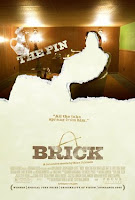 Brick. This movie is built on the most ingenious notion of setting a classic film noir story in a modern day high school. It takes the noir concepts of the loner detective, the femme fatale, the subversion of authority, the dealing with the underworld; and utilizes the clique driven social climate of high school, the natural teenage aversion to authority, the temptation of adolescents to fall in with the unsavory elements of life, and hands it all a slang vernacular that is half way between a Philip Marlowe novel and whatever words teens are inventing to make text messaging easier. It mashes it all together into this potboiler murder mystery that grabs the audience from the very first frame of the film where we find the hero observing the corpse of a girl lying in a culvert.
Brick. This movie is built on the most ingenious notion of setting a classic film noir story in a modern day high school. It takes the noir concepts of the loner detective, the femme fatale, the subversion of authority, the dealing with the underworld; and utilizes the clique driven social climate of high school, the natural teenage aversion to authority, the temptation of adolescents to fall in with the unsavory elements of life, and hands it all a slang vernacular that is half way between a Philip Marlowe novel and whatever words teens are inventing to make text messaging easier. It mashes it all together into this potboiler murder mystery that grabs the audience from the very first frame of the film where we find the hero observing the corpse of a girl lying in a culvert.I can imagine a cult of followers discussing the details of this film at length on the internet. Someone should be compiling a dictionary of the vocabulary of this film to land an easy publishing deal. This is the freshest movie I have seen in years. It creates a vitality all its own with the way these high school kids inhabit this world that has so many recognizable aspects of what makes up the life of the modern teenager, yet is so uniquely an environment that could only exist on film. This gargantuan concept and extravagant execution is securely delivered on the shoulders of its leading man played by the new king of independent film, “Third Rock from the Sun”’s Joseph Gordon Levitt. This is what film can be when approached as an art form as well as entertainment.
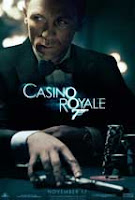 Casino Royale. “Bond is back!” in a light you may have never seen him before. Daniel Craig takes over as the double “O” super-spy James Bond, and the whole franchise has gone through a revamping not unlike what audiences saw last year with “Batman Begins”. Now Bond is grittier, based a little closer to reality, and more about character than the overproduced special effects extravaganzas audiences have been treated to with the last couple of installments in the series.
Casino Royale. “Bond is back!” in a light you may have never seen him before. Daniel Craig takes over as the double “O” super-spy James Bond, and the whole franchise has gone through a revamping not unlike what audiences saw last year with “Batman Begins”. Now Bond is grittier, based a little closer to reality, and more about character than the overproduced special effects extravaganzas audiences have been treated to with the last couple of installments in the series.Like “Batman”, Bond is given a new beginning here as we get to see the agent for the first time before he has achieved his assassin status. He quickly proves he has the cold nerves deserving of the rank, an aspect that Craig brings to the character with calm poise and disarming -- if not typical -- good looks. There are still some franchise signatures, such as the cocky Bond attitude, beautiful women roles -- both good and bad, and groundbreaking action sequences. But the lack of many of the series’ false notes means the audience is allowed to be more engaged in the story, which could be described with untypical Bond adjectives like, fascinating and brutal.
 The Departed. Martin Scorsese may finally be able to take home the big statue this year thanks to his deglamourized retelling of the Chinese action flick “Infernal Affairs”. Scorsese takes the thrilling premise from that film of an undercover police officer in the mob and a mob plant in the police department, who are each assigned by their respective organizations to uncover the other. Scorsese departs from the original material by focusing on the inner turmoil of the men created by their deceptive positions in the organizations they must pretend to be a part of while attempting to destroy; rather than the dichotomy shared by the two characters in the source material.
The Departed. Martin Scorsese may finally be able to take home the big statue this year thanks to his deglamourized retelling of the Chinese action flick “Infernal Affairs”. Scorsese takes the thrilling premise from that film of an undercover police officer in the mob and a mob plant in the police department, who are each assigned by their respective organizations to uncover the other. Scorsese departs from the original material by focusing on the inner turmoil of the men created by their deceptive positions in the organizations they must pretend to be a part of while attempting to destroy; rather than the dichotomy shared by the two characters in the source material.Fueled by powerful performances in the leads from Leonardo DiCaprio as the cop and Matt Damon as the mob plant, to shimmering supporting performances from Jack Nicholson, Martin Sheen, Alec Baldwin, Ray Winstone, and Mark Whalberg, “The Departed” is an uncompromising look at lives based so heavily on deception that the characters can no longer discern even when they are deceiving themselves. With searing character portrayals and brief snatches of violence, “The Departed” remembers what a force Scorsese is when depicting the brutal nature of crime in America.
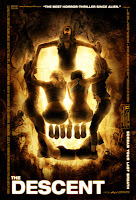 The Descent. Writer/director Neil Marshall is promising to be the next great mind in horror. With only his second film, he has created one of the few truly great horror masterpieces. “The Descent” joins the small ranks of horror flicks that take the time to build upon the audiences fears before exploiting them, enhancing the horror experience ten fold.
The Descent. Writer/director Neil Marshall is promising to be the next great mind in horror. With only his second film, he has created one of the few truly great horror masterpieces. “The Descent” joins the small ranks of horror flicks that take the time to build upon the audiences fears before exploiting them, enhancing the horror experience ten fold.Following a group of six female spelunkers into the dark caverns of an unexplored cave, Marshall skillfully pulls his audience in with a story focused on the characterization of its heroines/victims, allowing the viewer to search for the threat themselves for the greater part of the movie before pummeling the screen with a series of brutal violent images that will scare even the most stalwart of horror fans. “The Descent” is a film that has the potential to be looked back upon as a classic of its genre, and currently is the scariest flick to be found in the “New and Recent Releases” section of your local video store.
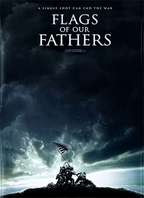 Flags of Our Fathers. James Bradley’s memoir of his grandfather’s involvement in the raising of the American flag at Iwo Jima and the subsequent media storm that followed that famous photo of the event acted as a subtle reminder to our great nation what sacrifices were made by the men who served our country on foreign shores and at home during that war. Director Clint Eastwood’s film adaptation of that book captures a like subtly without shying away from the horrors of the battlefield and how those days continue to haunt the men involved even as they are praised as heroes for the mere accident of appearing in the photo.
Flags of Our Fathers. James Bradley’s memoir of his grandfather’s involvement in the raising of the American flag at Iwo Jima and the subsequent media storm that followed that famous photo of the event acted as a subtle reminder to our great nation what sacrifices were made by the men who served our country on foreign shores and at home during that war. Director Clint Eastwood’s film adaptation of that book captures a like subtly without shying away from the horrors of the battlefield and how those days continue to haunt the men involved even as they are praised as heroes for the mere accident of appearing in the photo.Eastwood intercuts grand war scenes on the scale of the D-Day invasion of Normandy in Steven Spielberg’s “Saving Private Ryan” (“Flags of Our Fathers” was produced by Spielberg), with scenes of three of Iwo Jima’s heroes back stateside on a PR tour of the country for the desperately needed 7th U.S. Bonds War Drive for funds to keep America in the war. The tour has a sad tone as one soldier uses it as a platform to turn himself into a hero he never was, another despises himself for being seen as a hero while his buddies continue to fight oversees. Eastwood balances the character tragedies and triumphs with the politics of war time nationalism and the necessities and drawbacks of each.
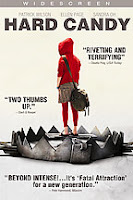 Hard Candy. There is cleanliness to this film that makes its subject seem all the more shocking. It is basically a two person drama between a photographer and a fifteen year-old girl whom he seduces online. She seems more eager to be with him than he with her, although that seems to be his strategy. But the whole thing is a set up by the girl, who turns out to be a much more dangerous predator than he could dream of being.
Hard Candy. There is cleanliness to this film that makes its subject seem all the more shocking. It is basically a two person drama between a photographer and a fifteen year-old girl whom he seduces online. She seems more eager to be with him than he with her, although that seems to be his strategy. But the whole thing is a set up by the girl, who turns out to be a much more dangerous predator than he could dream of being.“Hard Candy” does to its pedophile what we would all like to have done to such opportunistic predators. Using deception and cunning Ellen Page’s would be victim turns the tables, and in one scene appears to do the unthinkable. The filmmakers never allow either character to lose the smarts that are necessary to place them into this game with each other, and it is those brains that allow this revenge story to remain a thriller from start to finish. You actually may feel sympathy for the pedophile before everything is concluded.
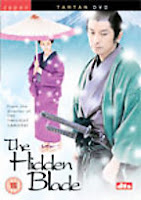 The Hidden Blade. There was a time when the Western was the most popular of American cinema genres. The same can be said of the Samurai picture in Japan. Few Westerns or Samurai pictures are made these days, as both seem to be slowly becoming forgotten genres, bred from the same dying lineage. There is one director still plugging away at Samurai films in Japan, and like Clint Eastwood has with the western, Yoji Yamada ages along with the genre, bringing it a graceful mature treatment in its twilight years.
The Hidden Blade. There was a time when the Western was the most popular of American cinema genres. The same can be said of the Samurai picture in Japan. Few Westerns or Samurai pictures are made these days, as both seem to be slowly becoming forgotten genres, bred from the same dying lineage. There is one director still plugging away at Samurai films in Japan, and like Clint Eastwood has with the western, Yoji Yamada ages along with the genre, bringing it a graceful mature treatment in its twilight years.“The Hidden Blade” tells the story of Munezo (Masatoshi Nagase), a samurai who has trouble adjusting to the modern western fighting technique of the late 19th century. He loves a woman who is below his caste, but saves her from her merchant husband’s abuse at the cost of his own standing in the community. When an old friend goes rogue, Munezo is asked to bring him in or kill him to prove his worth. Yamada seems to have a simple approach to this story and non-stylized direction, but what he ultimately produces is cinematic poetry.
 An Inconvenient Truth. Davis Guggenheim’s documentary following former Vice President Al Gore on his ongoing lecture tour to increase public awareness of the issues surrounding global warming is one of the most urgent films of the year. It tackles its subject of the growing problem of global warming in a very matter-of-fact manner. Made up almost entirely of lecture footage of Gore explaining the problem and offering small but effective solutions, the film is surprisingly compelling, perhaps due to the seriousness of the problem.
An Inconvenient Truth. Davis Guggenheim’s documentary following former Vice President Al Gore on his ongoing lecture tour to increase public awareness of the issues surrounding global warming is one of the most urgent films of the year. It tackles its subject of the growing problem of global warming in a very matter-of-fact manner. Made up almost entirely of lecture footage of Gore explaining the problem and offering small but effective solutions, the film is surprisingly compelling, perhaps due to the seriousness of the problem.Also surprising is the commanding and human presence of Gore himself as the harbinger of bad news in what is essentially a science lesson. Gore in this film does not resemble the rather dull prospect he seemed to represent as what he jokingly refers to as the man who “used to be the next President of the United States.” Gore turns a lot of scientific terminology and thought processes here into riveting layman’s terms, and is not afraid to poke fun at his own persona or add levity to what is in truth a very grave situation. The industrialization we have created is hurtling this planet quickly toward inhospitality, this film offers a step or two that can be taken by all to halt this process.
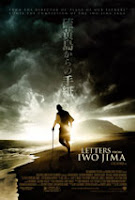 Letters from Iwo Jima. Director Clint Eastwood’s second take on the Battle of Iwo Jima shows the Japanese point of view. This film offers a very different perspective of war from his first Iwo Jima film “Flags of Our Fathers”. While that film looked at the national need for some hope of victory, which was delivered with the famous photo of the Marines raising the American flag on Mt. Suribachi; “Letters” shows soldiers operating upon little hope and a national outlook that has deceived and failed them through its dependence on blind tradition.
Letters from Iwo Jima. Director Clint Eastwood’s second take on the Battle of Iwo Jima shows the Japanese point of view. This film offers a very different perspective of war from his first Iwo Jima film “Flags of Our Fathers”. While that film looked at the national need for some hope of victory, which was delivered with the famous photo of the Marines raising the American flag on Mt. Suribachi; “Letters” shows soldiers operating upon little hope and a national outlook that has deceived and failed them through its dependence on blind tradition.What “Letters” makes clearest is that on the level of the combat soldier, every war is the same no matter which side you are on. The soldier fights out of duty for country and believes that he is on the right side. Not every soldier is necessarily good, but is driven by intentions he believes are good. The Japanese soldiers of Iwo Jima never had much of a chance, but Gen. Tadamichi Kuribayashi (Ken Watanabe) makes his best effort to ensure they do not die for no good reason when it is obvious they are considered to be a sacrifice in the face of imminent defeat by the Japanese Empire.
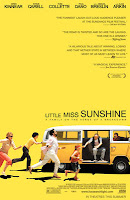 Little Miss Sunshine. All too often it is easy to dismiss comedy as a lesser approach to storytelling than drama. It would be easy to pass “Little Miss Sunshine” off as “cute,” when in actuality it is a very dear yet unsentimental look at what family is about. Consider what is done with the grandfather, if you want to try to confuse the term lighthearted with sentimental.
Little Miss Sunshine. All too often it is easy to dismiss comedy as a lesser approach to storytelling than drama. It would be easy to pass “Little Miss Sunshine” off as “cute,” when in actuality it is a very dear yet unsentimental look at what family is about. Consider what is done with the grandfather, if you want to try to confuse the term lighthearted with sentimental.This observant film is about an overly dysfunctional family, that somehow overcome their differences to travel cross-country in a VW bus so the youngest of them can compete in a beauty contest she hasn’t a chance of winning. It boasts an all-star cast in surprisingly inauspicious roles, including a self-help guru father who can’t seem to help himself, a heroine-addicted grandfather, a troubled teenage boy who has taken a vow of silence, a gay suicidal uncle who is the number one Proust expert in the country, and a mother trying to hold the whole thing together. It sounds like a typical situation comedy, but offers a fresh take on the idea of families having to live with who they all are together.
 Miami Vice. Michael Mann’s gritty retake on the ‘80s crime drama “Miami Vice” captures that series’ sense of glamour, open air of the Florida peninsula and sacrifice of the undercover cops of one of the nation’s most active port cities for drug trafficking. But in updating that once posh television show, Mann (“Heat”, “Collateral”) has invoked a city that has become nastier, more infested and more violent since the ‘80s.
Miami Vice. Michael Mann’s gritty retake on the ‘80s crime drama “Miami Vice” captures that series’ sense of glamour, open air of the Florida peninsula and sacrifice of the undercover cops of one of the nation’s most active port cities for drug trafficking. But in updating that once posh television show, Mann (“Heat”, “Collateral”) has invoked a city that has become nastier, more infested and more violent since the ‘80s.Once again following the adventures of vice cops Sonny Crockett (Colin Farrell) and Rico Tubbs (Jamie Foxx), little beyond the names resemble the television show, as Crockett and Tubbs go deep undercover to expose a major drug and weapons trafficker. Mann shows the unrelenting lives lived by the men and women of vice and how it’s impossible not to mix the business with the personal when you are in so deep. Audiences may have been disappointed with the film’s unresolved ending, which unfortunately reflects the never ending battle these police men and women face in their grueling daily careers.
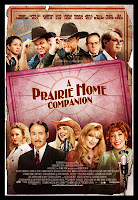 A Prairie Home Companion. Great American film director Robert Altman’s final film is a warm and lighthearted look at death through the eyes of a company of live radio performers on the eve of their final broadcast. “A Prairie Home Companion” is a fictional story based upon the real radio program of the same name, syndicated nationally by the NPR networks, written by its host and primary storyteller Garrison Kellior.
A Prairie Home Companion. Great American film director Robert Altman’s final film is a warm and lighthearted look at death through the eyes of a company of live radio performers on the eve of their final broadcast. “A Prairie Home Companion” is a fictional story based upon the real radio program of the same name, syndicated nationally by the NPR networks, written by its host and primary storyteller Garrison Kellior.Despite the story’s fictitious nature, the film plays like a slice of life of backstage and onstage life on the show, with Kellior playing the same MC role he carries on the actual program. It is filled with music both funny and serious from a by gone era when the primary form of entertainment for America was through radio programs much like this one. It is a wonderful example of Altman’s typical ensemble structure, which produces one of the best ensemble performances of the year, with big name stars and performers from the real “Prairie Home Companion” joining together in an evening of music and stories that will make you want to turn off your television and tune in to the very next episode of “A Prairie Home Companion” on the radio.
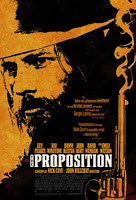 The Proposition. The western may be a dying breed, but it ain’t dead yet, although the characters in this one might just kill it as willingly as they kill themselves. Displacing the western to the Outback of Australia, screenwriter Nick Cave and director John Hillcoat have made the best western since Eastwood’s “Unforgiven”, and even possibly since Eastwood’s collaboration with Italian director Sergio Leone in the “Man with No Name” trilogy.
The Proposition. The western may be a dying breed, but it ain’t dead yet, although the characters in this one might just kill it as willingly as they kill themselves. Displacing the western to the Outback of Australia, screenwriter Nick Cave and director John Hillcoat have made the best western since Eastwood’s “Unforgiven”, and even possibly since Eastwood’s collaboration with Italian director Sergio Leone in the “Man with No Name” trilogy.Never have I felt so physically affected by a film’s location than here with this western’s setting in the desert Outback. Its dusty plains, relentless sun, and land that is as cracked and cragged as the characters that inhabit it will have you grasping for a glass of water, like a man lost in that same desert.
The story involves a clan of vicious criminal brothers. The sheriff of a collection of hovels in the middle of nowhere enlists the middle brother of the clan to hunt down and kill his older brother and keeps his kid brother locked up to be executed if he refuses the mission. These men are bad, but the town’s people are no better, demanding blood without justice. What can you expect from a British colony initially established as a place to send England’s worst criminals? These people deserve everything they get and they are quite aware they have been condemned to hell.
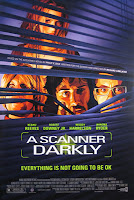 A Scanner Darkly. Richard Linklater (“Slacker”, “Dazed and Confused”, “School of Rock”) adapts the Philip K. Dick sci-fi noir to the screen in this highly overlooked animated feature. Utilizing the digital rotoscoping technique he developed for his 2001 film “Waking Life”, which is probably more popularly recognized from a series of commercials where upper middle classers are griping about their mutual funds, Linklater takes Dick’s convoluted undercover story of a cop who is assigned to take his own cover personality down for trafficking illegal substances, and turns it into a philosophical discussion of the transformative nature of drugs and the narcotics officers who must transform themselves to effectively police them.
A Scanner Darkly. Richard Linklater (“Slacker”, “Dazed and Confused”, “School of Rock”) adapts the Philip K. Dick sci-fi noir to the screen in this highly overlooked animated feature. Utilizing the digital rotoscoping technique he developed for his 2001 film “Waking Life”, which is probably more popularly recognized from a series of commercials where upper middle classers are griping about their mutual funds, Linklater takes Dick’s convoluted undercover story of a cop who is assigned to take his own cover personality down for trafficking illegal substances, and turns it into a philosophical discussion of the transformative nature of drugs and the narcotics officers who must transform themselves to effectively police them.Linklater does the best job I’ve seen him do of combining his talk heavy philosophical musings with an actual plot based storyline that has the proper amount of twists and turns to keep his characters thinking enough to warrant their tortured ramblings. The animation adds the right amount of fantasy and time-out-of-joint feeling to the material and provides him with a broad canvas on which his drug influenced characters can hallucinate and fantasize. This movie is the definitive mind-blowing trip.
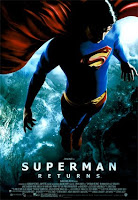 Superman Returns. During any given year I award four-star reviews that in retrospect I wonder whether I’ve given the filmmakers too much credit. As I began to gather opinion on the latest Superman from many people I respect, I began to wonder whether this was the case with a movie many were calling boring. After a chance to view “Superman Returns” a second time over, I have to stand by my original review. In fact, I found even more reason to appreciate and enjoy this non-standard comic book action hero flick the second time around.
Superman Returns. During any given year I award four-star reviews that in retrospect I wonder whether I’ve given the filmmakers too much credit. As I began to gather opinion on the latest Superman from many people I respect, I began to wonder whether this was the case with a movie many were calling boring. After a chance to view “Superman Returns” a second time over, I have to stand by my original review. In fact, I found even more reason to appreciate and enjoy this non-standard comic book action hero flick the second time around.Not only does “Superman Returns” do a wonderful job of what it is trying to do by honoring, imitating and improving upon the themes of the comic book and even more so the 1978 “Superman: The Movie” and it immediate sequel “Superman II”; but it transcends Superman’s personal issues with being an alien on Earth and a God among men. “Superman Returns” is practically a religious film, which may be better titled “The Passion of Superman”. Sure Lex Luthor’s plan to take over the world may be flawed, but the man is clearly insane as played by Kevin Spacey. But “SR” is deeper than the action that takes place within it. It is an exploration of the self and the soul and the place one must take in the world.
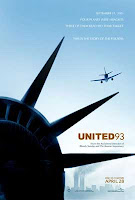 United 93. Director Paul Greengrass (“The Bourne Supremacy”) tackles the toughest film of the year in this depiction of the events which transpired on and around United Airlines flight 93 on the morning of September 11, 2001. The first half of the film focuses primarily on Air Traffic Control and NORAD control centers as they discover planes altering their courses and flying into buildings in New York and Washington. The second half of the film shows us what may have happened on the fourth hijacked plane that day before it crashed in a field in Pennsylvania.
United 93. Director Paul Greengrass (“The Bourne Supremacy”) tackles the toughest film of the year in this depiction of the events which transpired on and around United Airlines flight 93 on the morning of September 11, 2001. The first half of the film focuses primarily on Air Traffic Control and NORAD control centers as they discover planes altering their courses and flying into buildings in New York and Washington. The second half of the film shows us what may have happened on the fourth hijacked plane that day before it crashed in a field in Pennsylvania.What Greengrass accomplishes with this film is audacious in its realism and horrific in the way it presents such catastrophe in an almost documentary type of context. Never once does this film seem like a staged recreation. Nor does Greengrass, who also wrote the screenplay, seem to ever take sides in his presentation of that day’s sequence of events. There seems to be no judgment of the terrorist hijackers except by the civilian passengers who decide to take action against the captors with only the dimmest sense of hope to better the outcome of events.
“United 93” will be one of the harshest viewing experiences of your lifetime, as it is doubtful no one will ever forget the visceral emotional response of that day. This film is tribute to both the heroes in the air that day and those on the ground who did the best they could in an unprecedented situation.
 V for Vendetta. At a time when world politics seem to be spinning beyond anyone’s control, and the seats of power are being held by people you wouldn’t even trust to send on a beer run, perhaps it is necessary to have a message picture as blatant and in your face as “V for Vendetta”. Based on a comic book that was a reaction against Thatcherian rule in England during the seventies and early eighties, the makers of “The Matrix” have transported that story’s aggression to apply to our current state of affairs with this not-to-distant-future dystopian society flick.
V for Vendetta. At a time when world politics seem to be spinning beyond anyone’s control, and the seats of power are being held by people you wouldn’t even trust to send on a beer run, perhaps it is necessary to have a message picture as blatant and in your face as “V for Vendetta”. Based on a comic book that was a reaction against Thatcherian rule in England during the seventies and early eighties, the makers of “The Matrix” have transported that story’s aggression to apply to our current state of affairs with this not-to-distant-future dystopian society flick.Taking place in England after the American government has escalated the world sense of terror with a war in Iraq; the British government has assumed a more totalitarian rule with a Big Brother-type leader and branches of the government dispatched exclusively to keep watch on its citizens. V (Hugo Weaving) is a masked vigilante who begins his own crusade to oust the powers that be by bombing prominent government buildings. Evey (Natalie Portman) seemingly is an innocent who inadvertently gets wrapped up in V’s plans to blow up the Parliament building. But in the end she is an example of how it is everyone’s duty to stand up and question authority so such a society can never come into existence.
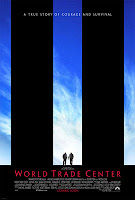 World Trade Center. The second 9/11 film of the year is as shocking as the first. Not because of its content, however, but for the fairly conventional storytelling approach taken by its usually controversial director Oliver Stone. In a year where the best films were risky and unconventional, Stone gave up his usual photographic and editorial trickery to tell a straightforward tale of the survival of two Port Authority officers who were caught in the rubble of the collapsed World Trade Center buildings.
World Trade Center. The second 9/11 film of the year is as shocking as the first. Not because of its content, however, but for the fairly conventional storytelling approach taken by its usually controversial director Oliver Stone. In a year where the best films were risky and unconventional, Stone gave up his usual photographic and editorial trickery to tell a straightforward tale of the survival of two Port Authority officers who were caught in the rubble of the collapsed World Trade Center buildings.Sgt. John McLoughlin (Nicolas Cage) and Will Jimeno (Michael Pena) were a few of the last survivors to be pulled from the Towers wreckage and Stone tells the story of how they kept each other alive during the nearly 48 hr. period they were trapped. As much a story of survival was the ordeal their wives, Donna (Maria Bello) and Allison (Maggie Gyllenhaal), went through in wondering whether their husbands were alive or not. Stone avoids depicting much of the actual collapse of the towers themselves, and the film remains fairly free of any special effects shots, which allows the audience to concentrate on what is a very basic human story of emotion and ultimately survival.
I also enjoyed: “Akeelah and the Bee”, “Cars”, “Clerks II”, “Dave Chappelle’s Block Party”, “The Devil Wears Prada”, “Factotum”, “Flushed Away”, “Friends with Money”, “High Tension”, “Inside Man”, “Joyeux Noel”, “Kinky Boots”, “Lady in the Water”, “Lady Vengeance”, “L’Enfant”, “Leonard Cohen: I’m Your Man”, “Mission: Impossible III”, “Monster House”, “Neil Young: Heart of Gold”, “Night Watch”, “The Omen”, “Slither”, “Talladega Nights: The Ballad of Ricky Bobby”, “U2//Vertigo ’05: Live in Milan”, “Winter Passing”, and “X-Men: The Last Stand”.
As I do every year. I have also included best of lists of my favorite performances, directors, songs, and various credit efforts of many different categories. Some of them are the ones you’ll see in all the awards shows, some are a little more obscure subjects which I have made up on my own. Some categories will include pictures that did not make my Best of movies list and are an insight as to where else to look for great performances and the such. Enjoy.
Best Director: Paul Greengrass, “United 93”.
Honorable mention: Martin Scorsese, “The Departed”; Clint Eastwood, “Flags of Our Fathers” and “Letters from Iwo Jima”; Oliver Stone, “World Trade Center”; Yoji Yamada, “The Hidden Blade”; Chanwook Park, “Lady Vengeance”; Michael Mann, “Miami Vice”.
Best Actor: Leonardo DiCaprio as Billy Costigan in “The Departed”.
Honorable mention: Nicolas Cage as Sgt. John McLoughlin in “World Trade Center”; Masatoshi Nagase as Munezo in “The Hidden Blade”; Paul Giamatti as Cleveland Heep in “Lady in the Water”; Chiwetel Ejiofor as Ian Carter in “Tsunami, the Aftermath” and as Lola in “Kinky Boots”; Matt Dillon as Henry Chinaski in “Factotum”; Jack Nicholson as Frank Costello in “The Departed”; Adam Beach as Ira Hayes in “Flags of Our Fathers”; Alec Baldwin as Ellery in “The Departed”; Ray Winstone as Captain Stanley in “The Proposition” and as Mr. French in “The Departed”.
Best Actress: Maggie Gyllenhaal as Allison Jimeno in “World Trade Center”.
Honorable mention: Meryl Streep as Miranda Priestly in “The Devil Wears Prada” and as Yolanda Johnson in “A Prairie Home Companion”; Ellen Page as Hayley Stark in “Hard Candy”; Maria Bello as Donna McLoughlin in “World Trade Center”; Yeong-ae Lee as Guem-ja Lee in “Lady Vengeance”; Frances McDormand as Jane in “Friends with Money”; Jessica Lange as Doreen in “Don’t Come Knocking”; Sophie Okonedo as Susie Carter in “Tsunami, the Aftermath”; Toni Collette as Kathy Graham in “Tsunami, the Aftermath” and as Sheryl in “Little Miss Sunshine”; Emily Blunt as Emily in “The Devil Wears Prada”.
Best Ensemble: “United 93”.
Honorable mention: “Lady in the Water”, “The Departed”, “The Proposition”, “A Prairie Home Companion”, “Little Miss Sunshine”.
Breakthrough performance: Brandon Routh as Clark Kent/Kal-El/Superman in “Superman Returns”.
Honorable mention: Abigail Breslin as Olive in “Little Miss Sunshine”.
Best Screenplay: Nick Cave, “The Proposition”.
Honorable mention: Rian Johnson, “Brick”; Brian Nelson, “Hard Candy”; Jean-Pierre and Luc Dardenne, “L’Enfant”; M. Night Shyamalan, “Lady in the Water”; Michael Arndt, “Little Miss Sunshine”.
Best Adaptation: Richard Linklater, “A Scanner Darkly” from the novel by Philip K. Dick.
Honorable mention: William Monahan, “The Departed” from the screenplay “Wu jian dao (Infernal Affairs)” by Alan Mak and Felix Chong; William Broyles Jr. and Paul Haggis, “Flags of Our Fathers” from the novel by James Bradley and Ron Powers; Yoshitaka Asama, “The Hidden Blade” from the novel by Shuuhei Fujisawa; Neal Purvis & Robert Wade and Paul Haggis, “Casino Royale” from the novel by Ian Fleming; Iris Yamashita and Paul Haggis, “Letters from Iwo Jima” from the book “Picture Letters from Commander in Chief” by Tadamichi Kuribayashi and Tsuyoko Yoshido.
Best Animated feature: “A Scanner Darkly”.
Honorable mention: “Cars”, “Monster House”, “Flushed Away”.
Best Voice-over performance: Larry the Cable Guy as Mater in “Cars”.
Honorable mention: William Shatner as Ozzie the possum in “Over the Hedge”, Ian McKellen as The Toad in “Flushed Away”.
Best performance in a mask since Edward Norton as King Baldwin in “Kingdom of Heaven”: Hugo Weaving as V in “V for Vendetta”.
Best Score: Nick Cave and Warren Ellis, “The Proposition”.
Honorable mention: Mychael Danna and DeVotchKa, “Little Miss Sunshine”; Hans Zimmer, “The Da Vinci Code”; T-Bone Burnett, “Don’t Come Knocking”; James Newton Howard, “Lady in the Water”; John Ottman and John Williams, “Superman Returns”.
Best Song: Nick Cave, “The Rider Song” from “The Proposition”.
Honorable mention: Thom Yorke, “Black Swan” from “A Scanner Darkly”; DeVotchKa, “You Love Me (remix)” from “Little Miss Sunshine”.
Best Cinematography: Benoit Delhomme, “The Proposition”.
Honorable mention: Dion Beebe, “Miami Vice”; Tom Stern, “Flags of Our Fathers” and “Letters from Iwo Jima”; Franz Lustig, “Don’t Come Knocking”; Joe Willems, “Hard Candy”; Jeong-hun Jeong, “Lady Vengeance”.
Best Editing: Clare Douglas, Richard Pearson and Christopher Rouse, “United 93”.
Honorable mention: William Goldenberg and Paul Rubell, “Miami Vice”; Thelma Schoonmaker, “The Departed”; Baxter and Sophie Vermersch, “High Tension”; Jae-beom Kim and Sang-beom Kim, “Lady Vengeance”, Dmitri Kiselev, “Night Watch”.
Best Title credits: “Superman Returns”
Best Poster: “The Descent”.
Honorable mention: “V for Vendetta”, “World Trade Center”, "The Good German", "An Inconvenient Truth", "The Proposition" .
Best DVD: “Kingdom of Heaven: The Director’s Cut”.
Honorable mention: “Saturday Night Live 1975-1976: The Complete First Season”.
Worst picture: “Bloodrayne”.
Dishonorable mention: “Ultraviolet”, “Grandma’s Boy”, “Underworld: Evolution”, “Ultimate Avengers: The Movie”, “Poseidon”, “Date Movie”, “Idlewild”, “The Who: Live at Lyon”.





No comments:
Post a Comment